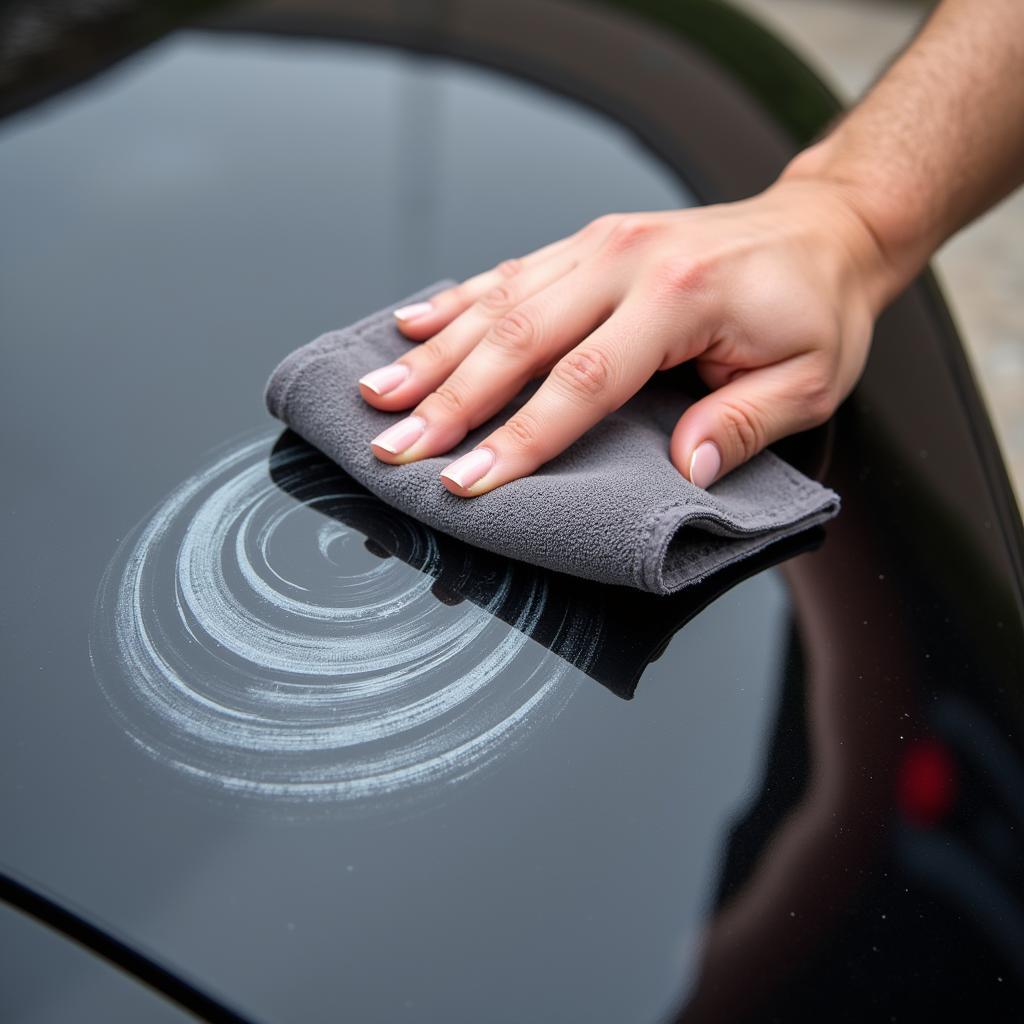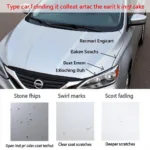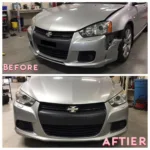DIY repair car paint scratches can seem daunting, but with the right knowledge and tools, you can achieve professional-looking results and save money. This guide provides a comprehensive approach to fixing those unsightly blemishes, from minor clear coat scratches to deeper paint chips.
Fixing car paint scratches yourself can be a rewarding experience. Let’s dive into the different methods, tools, and techniques to help you restore your car’s finish to its former glory. You can achieve surprisingly good results with a little patience and the right approach. For more specific advice on touch-up paint, check out our guide on car scratches touch up paint repair.
Assessing the Damage: Know Your Scratch
Before you begin any DIY repair car paint scratches project, it’s crucial to understand the extent of the damage. Scratches are categorized by depth:
- Clear Coat Scratches: These are the most superficial, affecting only the clear coat protecting the paint. They often appear as light, swirling marks.
- Minor Paint Scratches: These penetrate the clear coat and slightly into the base coat, revealing a faint color difference.
- Deep Paint Scratches: These reach the primer or even the bare metal, requiring more extensive repair.
Identifying the type of scratch will determine the appropriate repair method. For example, a simple polishing compound might suffice for clear coat scratches, whereas deeper scratches necessitate touch-up paint and possibly even primer.
Gathering Your DIY Car Paint Scratch Repair Arsenal
Having the right tools for DIY repair car paint scratches is essential. Here’s what you’ll need:
- Car Wash Supplies: Thoroughly cleaning the area is the first step.
- Microfiber Cloths: These lint-free cloths are perfect for cleaning and applying products.
- Rubbing Compound (for clear coat scratches): This abrasive paste removes fine scratches and restores shine.
- Polishing Compound (for minor paint scratches): This finer abrasive further refines the surface and removes swirl marks.
- Touch-Up Paint (for deep paint scratches): Choose a paint pen or bottle that precisely matches your car’s color.
- Primer (for deep scratches reaching metal): Prevents rust and provides a base for the touch-up paint.
- Clear Coat (for deep scratches): Seals and protects the repaired area.
- Sandpaper (for deep scratches): Use fine-grit sandpaper (2000-3000 grit) to smooth the area before applying primer.
- Masking Tape: Protects surrounding areas during the repair process.
- Applicators: Use foam applicators for even product distribution.
If you’re looking for a convenient all-in-one solution, consider a DIY car paint repair kit. These kits usually contain most of the necessary supplies.
Step-by-Step Guide to DIY Repair Car Paint Scratches
How to Repair Clear Coat Scratches
- Wash and Dry: Thoroughly clean the scratched area with car wash soap and water, then dry it completely.
- Apply Rubbing Compound: Apply a small amount of rubbing compound to a microfiber cloth and rub it onto the scratch using circular motions.
- Buff and Wipe: Buff the area with a clean microfiber cloth until the scratch disappears.
Repairing Minor Paint Scratches
- Clean the Area: Wash and dry the scratched area thoroughly.
- Apply Polishing Compound: Apply polishing compound using the same technique as rubbing compound.
- Buff and Inspect: Buff the area until the scratch is less noticeable.
If the scratch is still visible, consider using a car repair paint pen for precise application of touch-up paint.
Addressing Deep Paint Scratches
- Clean and Prepare: Clean the area and use fine-grit sandpaper to smooth the edges of the scratch.
- Apply Primer (if necessary): If the scratch reaches the metal, apply a thin layer of primer.
- Apply Touch-Up Paint: Carefully apply thin layers of touch-up paint, allowing each layer to dry before applying the next. You might find paint repair pens for cars helpful for precise application.
- Apply Clear Coat: Once the touch-up paint is dry, apply a thin layer of clear coat to protect the repair.
- Sand and Polish (if needed): After the clear coat dries, you may need to lightly sand and polish the area for a smooth, seamless finish. For deeper key scratches, refer to our guide on how to repair key scratches on car paint.
Conclusion
DIY repair car paint scratches can be an effective and cost-saving solution for minor to moderate damage. By understanding the type of scratch and following the appropriate steps, you can restore your car’s appearance and protect it from further damage. Remember, patience and attention to detail are key to achieving professional-looking results.
FAQ
- Can I use any type of rubbing compound? It’s best to use a rubbing compound specifically designed for automotive paint.
- How long does touch-up paint take to dry? Drying times vary depending on the product and environmental conditions, but it typically takes a few hours.
- What if the scratch is too deep to repair myself? For very deep or extensive scratches, it’s recommended to consult a professional auto body shop.
- How can I prevent future scratches? Regular waxing and careful car washing can help protect your car’s paint.
- What should I do if the touch-up paint doesn’t match perfectly? Slight color variations can occur. Consider consulting a paint specialist for a precise color match.
- Can I use nail polish to repair a car scratch? No, nail polish is not formulated for automotive paint and can damage the clear coat.
- Where can I find touch-up paint for my car? You can find touch-up paint at auto parts stores, dealerships, or online.
Have other questions or need further assistance? Reach out to our 24/7 customer support team via WhatsApp: +1(641)206-8880, or Email: [email protected]. We’re here to help!



